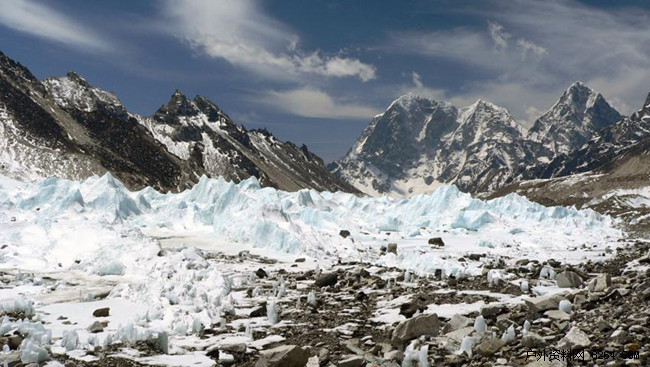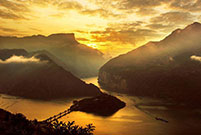

 |
| Glaciers on Mount Qomolangma (File photo) |
LHASA, Dec. 8 -- Glaciers on Mount Qomolangma have shrunk by 28 percent over the past 40 years due to climate change, according to a report released over the weekend.
The glacial shrinkage area is compared to the measurements taken in the 1970s. The glacier area on the south slope of the mountain, in Nepal, has decreased 26 percent since the 1980s, according to the report co-released by the Chinese Academy of Sciences (CAS), Hunan University of Science and Technology, and Mount Qomolangma Snow Leopard Conservation Center.
Kang Shichang, a researcher with the State Key Laboratory of Cryospheric Sciences under the CAS, said the data was based on long-term remote sensing and on-site monitoring.
At present, there are 1,476 glaciers in China's Mt. Qomolangma national nature reserve, covering 2,030 square kilometers.
The shrinking glaciers have resulted in swelling glacial lakes and higher river levels downstream, said Kang, who has led several glacier inspection teams.
Remote sensing data showed that the area of a glacial lake in Mt. Qomolangma nature reserve increased from about 100 square kilometers in 1990 to 114 square kilometers in 2013, Kang said.
The 8,844-meter-high Mt. Qomolangma, located on the border of China and Nepal, is the world's highest mountain.
 All-star Carnival held in Beijing
All-star Carnival held in Beijing Charming female bodybuilders of Chengdu University
Charming female bodybuilders of Chengdu University Polish sports stars strip off for risqué calendar
Polish sports stars strip off for risqué calendar Spectacular aerial photos of the Three Gorges
Spectacular aerial photos of the Three Gorges Contestants of Mrs. Globe pose for photo in Shenzhen
Contestants of Mrs. Globe pose for photo in Shenzhen
 Bikini models attend hot pot banquet in Hefei
Bikini models attend hot pot banquet in Hefei J-10B fighters with homegrown engine in test fligh
J-10B fighters with homegrown engine in test fligh Photos of U.S. Navy intruding in South China Sea released
Photos of U.S. Navy intruding in South China Sea released Cats who immediately regretted their life choices in photographs
Cats who immediately regretted their life choices in photographs Top 20 hottest women in the world in 2014
Top 20 hottest women in the world in 2014 Top 10 hardest languages to learn
Top 10 hardest languages to learn 10 Chinese female stars with most beautiful faces
10 Chinese female stars with most beautiful faces China’s Top 10 Unique Bridges, Highways and Roads
China’s Top 10 Unique Bridges, Highways and RoadsDay|Week